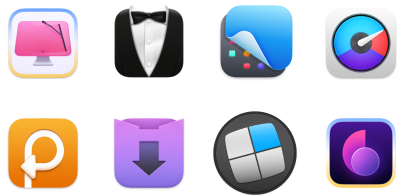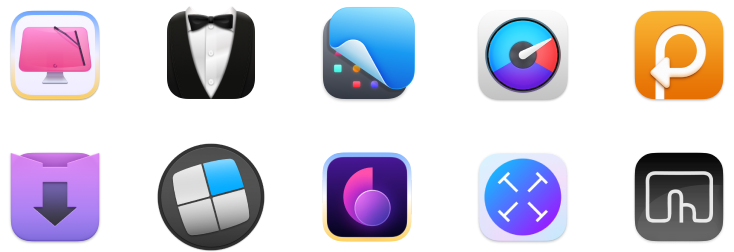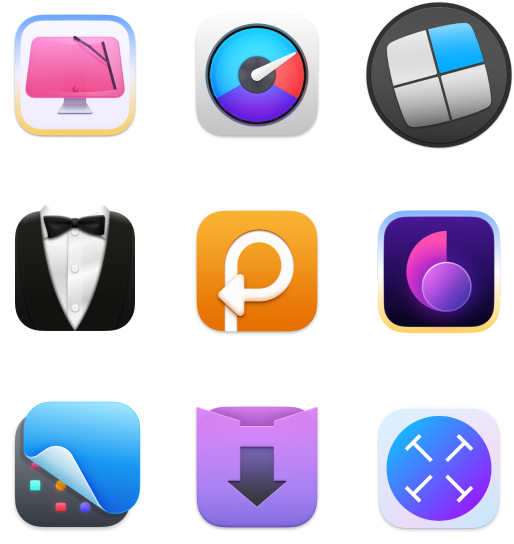What does a day in the life of a graphic designer look like? Wince at the sight of poor fonts. Go to a website and close it immediately because you hate the colors. Try to persuade your manager you need both Photoshop and Lightroom. Yeah, I know the pain.
Unfortunately, I can’t talk to your boss about the Adobe subscription. What I can do is to ensure you have the right fonts — always close at hand.
Font organization is only as useful as you feel comfortable using it. That’s why Font Book often isn’t enough—it offers minimal customization and limited features. I spoke with some of my designer colleagues and put together a list of the four most frequently recommended font management apps. You can add any of them to your Mac and start saving time on font selection right away.
Below is a quick overview of these tools. Scroll down for a detailed breakdown.
Let’s compare! Typeface RightFont FontBase Glyphs Mini
Superpower Font organization and management
Advanced font organization
Beginner-friendly font management
Font editing and creation
Best for All proficiency levels, designers
Professional designers, teams
Beginner designers
Designers, students editing fonts
What you’ll love
- Customizable font previews
- Font syncing via iCloud/Dropbox
- Simple UI
- Font editing
Font editing No
No
No
Yes
Platforms macOS
Mac, Windows, Linux
Mac, Windows, Linux
macOS
Price
Included in Setapp*
$59 single license
Free plan
Included in Setapp*
*The underlined apps are available on Setapp — a platform with 250+ apps for macOS, iOS, and web. Try them all free for 7 days.
Typeface: Organize, preview, and share fonts effortlessly
Finding an all-in-one font organizer can be challenging. Well, it’s where Typeface comes in. Unlike the clumsy Font Book and the overcomplicated RightFont, Typeface works as a designer’s personal assistant — whatever the proficiency level.
If you decide to dig deeper into this app, you’ll quickly see how much people love it. One of the common praises is the huge collection of thousands of fonts: "I use Typeface. It works great. I've got over 13,000 fonts, and you can just turn on the font you want, but it doesn't load in your system. Plus you can preview all the fonts with anything you type, so you can just look at it and choose the best font for the job.. On Setapp, the app has an impressive 98% positive review rate, with comments like “Wish macOS font manager was as good.”
Here’s what you can do with the Typeface font manager:
Control your fonts A user decides how the fonts should be displayed on a Mac’s screen. From preview samples to font size and blurring effects, you can completely customize your Typeface journey. The best thing is you can actually create instant mockups that show you how a particular font will look on a project.
Keep all the right fonts at hand
Search is the best part of the app. To find a font you need, browse through the categories on the sidebar, or type in the name in the upper right corner. The fonts are grouped by families, so it’s easier to navigate between different typefaces.
You can take a closer look at each font by clicking on it. Not only will you see the sample text, every font page also covers the detailed metadata and all the letterforms. If you switch to the Info tab, you’ll also see the list of supported languages as well as tags for this particular font.
Curation functionality
Let’s make one thing clear. You need personalized collections if you work with different fonts. Typeface not only records your collections, it also allows you to share particular sets of fonts with the whole team with a click. As you browse through available fonts, you can save them to a quick collection on the spot and organize them into collections later. All you have to do is grab a font and drag and drop it onto the quick collection button in the upper left corner.
✕ Remove app banner
Who’s it for?
Everyone. Whether you are a professional graphic designer with your personal base of fonts, or you can’t tell the difference between a font and typeface, this app is for you.
Why yes
Focus on all proficiency levels Customizable font collections A quick collection feature Available with Setapp subscription Why no
Works on macOS only Can be pricey when bought outside of Setapp (from $42.99/user on the official website or $49.99 on the Mac App Store) What’s the price?
Included in Setapp . You only pay for a fixed monthly subscription, which gives you access to an all-in-one pack of 250+ apps for macOS and iOS Free trial available RightFont: Seamless font management and team sync
RightFont is an advanced solution on how to organize fonts. The app works on Mac, Windows, and Linux — so it’s handy if you design for different operating systems. Plus, RightFont works with all major design software like Sketch, Adobe CC, Illustrator, and more.
The app embraces many roles you can benefit from:
Font management . Create curated font libraries based on your project specifications. Font Syncing . Share your font files with colleagues via iCloud or Dropbox. Cloud fonts . Easily install and use Google or Adobe fonts. Font auto activation . Solve the problem with missing fonts through instant auto activation. So that whenever you open a program that has missing fonts, you can bulk install them. Who’s it for?
Professional graphic designers. Even better — teams of designers working on shared projects. The volume licence will cost you less if you use the app on multiple devices. The maximum number of seats you can get is 50 ($40 per device versus the regular price of $45).
Why yes
Auto-activation of fonts Grid view for easy comparison of two fonts Sharing font collections via Dropbox and other cloud services Why no
Steep learning curve Support and updates are available for one year after purchase. What’s the price?
$59.00 per single license on the official website Starting $55.15 per device with a volume license (2+ devices) FontBase: Beginner-friendly font manager app
You can get the feel of your fonts with FontBase — free of charge. The only font manager that offers a free plan, this app does a good job if you’re interested in features like font upload, Google fonts management, and a simple UI.
Add the new fonts by dragging them to a specific folder. You can also create and customize your own collections of fonts. In the preview, you’ll be able to switch between styles, glyphs, and waterfall.
The main disadvantage is the preview section. It’s pretty basic and doesn’t allow simple customization. For instance, you’ll have to get a paid plan to have access to grid view.
Who’s it for?
The app is uncomplicated and can be used by beginners. For everyday use, designers will lack flexibility in terms of previews as well as won’t be able to auto activate fonts with a free plan. So I recommend getting FontBase Awesome — a paid subscription plan — if you need an advanced solution.
Why yes
Simple UI Advanced glyphs and views with the paid plan Google fonts support Why no
Doesn’t make much use without upgrading to a pro plan What’s the price?
FontBase is the only free font manager on the list. Well, kind of. With the free version, you get a set of basic features like font collections, search, Google fonts installation, and more. However, to get access to the extended functionality — auto activation, super search, and multiple views — you have to upgrade to FontBase Awesome, which is a $3 monthly subscription.
Glyphs Mini: Shape your typography, create and tweak fonts
While font managers excel at keeping fonts organized in collections and making collaboration and sharing easy, they don’t let you make any adjustments to the fonts themselves, which you frequently need to do as a designer — for example, when creating logotypes with custom fonts.
Glyphs Mini can be your perfect font editor, allowing you to quickly create letter changes and icon designs of any complexity. The app is intuitive and easy to use for beginners as well, when you only need to edit just a few vector lines.
For professionals, Glyphs Mini offers shape templates so you can adjust the fonts consistently, coordination panels to verify your changes, filters to edit specific letters, and lots of other font-specific settings.
Who’s it for?
Anyone who likes to tinker with various fonts and make adjustments to letter shapes. Graphic design students will also find Glyphs Mini very helpful.
Some users feel a bit intimidated by the app’s pricing. As one Reddit user put it: “If you have the money, Glyphs is unparalleled in my book. The application is incredibly flexible, intuitive, and robust, especially if you’re working with multiple masters.” . But I think it’s safe to say that if you get the app through Setapp, the price feels fair, especially considering you’re also getting access to 250+ other tools, many of which are perfect for various design tasks.
Why yes
Powerful font editing capabilities Letter shape templates Extensive font format and vector support Why no
Not for everyone Expensive if bought outside of Setapp ($49 on the official website ) What’s the price?
$49 when bought through the App Store Free with a seven-day trial of Setapp . Then, a flat monthly fee for 250+ apps.
✕ Remove app banner
How to manage fonts on Mac: For those who stick to built-in apps
Sometimes, you might not be ready to bring extra tools into your workflow — and that’s totally okay. In that case, you can simply start with the built-in software on your Mac.
Apple knows a designer’s pain points as well. So it created Font Book, a free font manager that allows you to install and remove fonts on your Mac . The program is very basic, but works for a beginner as well as non-designers who need font variety.
Enable and disable fonts
You can’t actually delete fonts, but you can make sure you don’t see the unneeded ones in your collection. Font Book comes with font families, so you can decide whether you want to disable the whole family or a particular font:
Select a font family or click on the arrow next to it to open the list of fonts Go to Edit in the menu bar and select Disable Choose Disable All to get rid of the full collection
You can also download a new font from the internet and use it with Font Book (the supported extensions are otf, .ttf, and .ttc). Once you unpack a zip with a new font, select the file with a corresponding extension to open preview and click Install Font. This will get the font right into your Font Book.
Bring fonts into libraries and collections
Font Book has four default libraries: All, English, User, and Computer. The last two are stored in the Library folder. User fonts are available to the admin only, and Computer fonts — to anyone accessing a Mac.
If these are not enough, you can create your custom libraries of fonts:
Go to the File menu and select New Library Give the library a name and click Enter to save Drag the selected fonts from All Fonts to your custom library You can also customize libraries by creating collections inside them. These will point to specific installed fonts across your libraries. To add new collections, select File ➙ New Collection. Once you’ve saved it, drag fonts to the collection the same way you’ve done with libraries. Alternatively, click the plus button in the bottom left corner to add fonts.
Note that you don’t remove a font from its original collection when you drag it somewhere else. So you’ll still need to disable it if you don’t want to have duplicates across collections.
Verdict: The best font manager for Mac
If you know graphic design backwards and forwards, get RightFont. It’s gonna be expensive, but will pay off in the long run.
FontBase is your choice if you’re just starting out — once you learn the ropes, you can upgrade to the pro plan and expand the toolkit.
Typeface and Glyphs Mini , however, bring a complete font managing and editing workflow right to your fingertips, with functionality perks for pros and intuitive design for beginners.
Best of all, these apps are all available via Setapp , in addition to more than 250 apps like IconJar for quick icon management, and Goldie App to instantly visualize golden ratio on a Mac. Try them all at no cost today!
FAQ
Font or typeface, what’s the difference?
In graphic design, the notions of font and typeface are often used interchangeably. They are not the same, though. Coming from the age of the printing press, fonts were used as the variations of a typeface family — differing in weight, size, etc. So basically, a font is a set of characteristics that define a style of a typeface. On a Mac, you have fonts, each of which is an individual style with distinctive width and weight properties — even though they might belong to the same typeface. For instance, if you say Verdana, you mean a family of fonts which includes Verdana Regular, Verdana Italic, and more.
Why do you need a Mac font manager?
Fonts and colors define content. That’s something most graphic designers will tell you, and that’s the way our visual perception works. Even if you think you know nothing about design, try to change fonts in your Instagram stories. They will look totally different — some of them appearing to suit well, the others being completely out of place.
If you do graphic design for a living, you probably have dozens of fonts that work for specific types of design. Plus, you can choose a typeface that is trendy and gives your content a modern look without damaging the clarity of text. To keep up the good work, you have to keep exploring.
Font management software helps designers organize fonts, easily view the selected ones, rename or delete the fonts that are no longer needed. Saves time and keeps your work professional.
What are the essential font manager features?
Compelling UI. It’s quite a challenge to find a tool that combines a font checker, organizer, and installer. It’s even harder to find the one that looks well on your screen and never distracts you from the job. When it comes to a design workflow, UI will mean everything. So we recommend paying attention to the tools that adjust to your design software — ideally, allow you to navigate across fonts via a handy sidebar.Filtering and collections. Why else would you land here? The app you choose should know how to organize fonts on Mac. The more flexible it goes in terms of collections, libraries, and preview options — the better.Customization. The main reason you should go for a Font Book alternative is it’s not customizable enough. With Apple’s in-built font organizer, you won’t be able to preview fonts in different sizes. What’s more, your font preview will always open in a new window. The advanced font apps will let you see how a font looks on your particular project — instantly.






